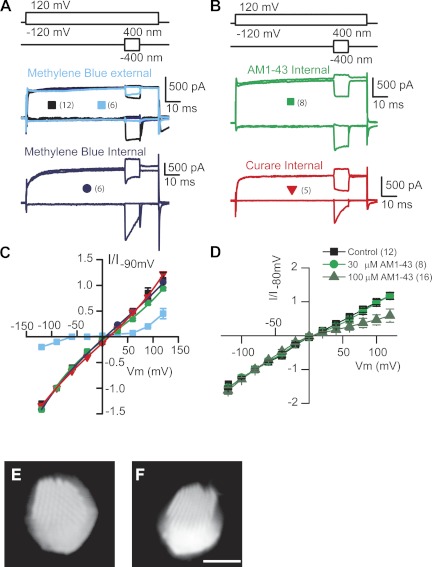Fig. 1.
Permeable channel blockers are ineffective from the internal face of the mechanoelectric transducer (MET) channel. A: protocol (top) shows the electrical (upper) and mechanical (lower) stimuli used to generate current-voltage plots for the MET channel. Middle traces show MET currents elicited in the absence (black) and presence (blue) of methylene blue (MB; 1 mM) externally. Bottom traces show another cell recorded with MB internally (1 mM). B: stimuli (top) and MET currents recorded with AM1-43 (middle) or curare (bottom) included in the recording pipette, showing no effect on MET currents. Symbols in A and B are key for the plots in C; number of recorded cells is presented in parentheses. C: summary of the current-voltage plots for A and B demonstrating no effect with intracellular blockers. Data are fit with a single-site binding model equation. Also included is extracellular MB application demonstrating a classic pattern for a permeant blocker with escape from block achieved at both depolarizing and hyperpolarizing potentials (Farris et al. 2004). D: current-voltage plots for higher concentrations of intracellular AM1-43 showing that at concentrations 30 times that of the extracellular Kd, there is a partial block of the current. Again, fits are to the single-site binding equation. Error bars are SE. E and F: 2-photon imaging of Alexa 488-conjugated dextrans (3,000 MW dextran in E, 10,000 MW dextran in F) demonstrates that large molecules can enter the stereocilia. Scale bar is 5 μm for both panels. Images show hair bundles from a top down (E) and a more side view (F) to show stereo cilia are loaded. I/I, normalized current; Vm, voltage potential.

